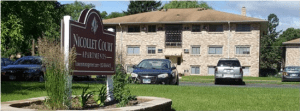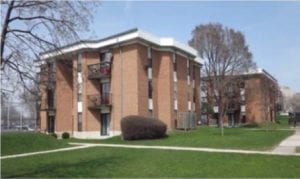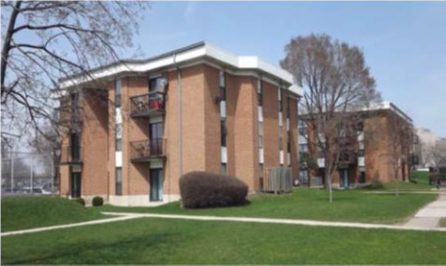
in Bloomington and Brooklyn Center, Minnesota, four buildings with 239 units were preserved using the NOAH Impact Fund. Photo courtesy of the National Housing Trust
Before the pandemic, housing stability was already a fraught issue for many Americans. Only 1 in 4 households eligible for federal housing assistance were receiving it. The remaining 75 percent had limited options available to them and many struggled to find market-rate housing that was affordable. Now, as the COVID-19 pandemic continues, vast numbers of households face housing instability.
Naturally occurring affordable housing (NOAH) plays a vital role in providing affordable housing options for low- and moderate-income families and could be part of a national COVID-19 approach. That’s because units in NOAH properties tend to rent at rates that are broadly affordable to households at around 50 percent of Area Median Income (AMI), without public subsidy, according to a CoStar report. The rents are more affordable because these properties are typically composed of Class B and Class C real estate, where buildings are older, likely in need of renovation, and located in less desirable neighborhoods. While these factors keep rents low in NOAH properties, this housing has increasingly become at risk of exiting the affordable housing stock due to building obsolescence, inadequate unit quality, and market pressures.
And now, as unemployment rates rise and renters are unable to pay rent, NOAH property owners will likely struggle to meet their financial obligations. As a type of housing that receives no federal subsidy, NOAH buildings have been excluded from the emergency assistance packages that have passed recently. Real estate investors who can offer capital in exchange for ownership will target landlords who face financial loss. Mirroring actions seen during the 2009 subprime mortgage crisis, these developers will seek to purchase buildings, provide upgrades to the units, and then rent them at rates beyond the reach of current residents.
NOAH properties make up about 63 percent of the affordable housing stock in the U.S, surpassing the amount of income-restricted subsidized affordable housing. Without affordability restrictions in place, like those offered by the Low Income Housing Tax Credit (LIHTC) or public housing, these units could be lost forever.
A Strategy for Preservation
Purchasing NOAH properties can be a challenge because mission-oriented investors committed to preserving affordability are competing in the same market where the acquisition price is set by the potential purchasers of any given building, which will invariably include market-rate developers. For prospective NOAH owners to compete and preserve affordability, they need access to financing which lets them offer the same, or higher, amount to the seller.
However, it is not possible to offer the same return to investors without raising rents. For this reason, a fund that targets a market-rate return for investments is unlikely to support long-term affordability, as it necessitates raising rents in the same way that a market-rate developer would plan to do.
Accessing the appropriate financing, however, allows nonprofit developers to match the purchase offers of market-rate developers who seek to raise rents and convert NOAH stock into more expensive housing. In response to this need, private and public entities across the country have created tools that allow developers to access the resources they need to acquire and preserve NOAH. Although most investors desire market-rate returns, there are several examples of funding available for NOAH properties that appropriately incentivize investors with returns and support the mission of long-term affordability for NOAH buildings.
Three Funds for NOAH properties
Along the wide spectrum of funds, each has a different level of public sector involvement and mission-orientation. Each fund is unique, and exists on a spectrum of funders, affordability requirements, exit strategies, and implications for policymakers. When considering the possibility of working with NOAH funds in your community, it is important to ask the following questions:
- What types of buildings is the fund supporting to purchase? Is the fund focused in areas of opportunity, small properties, or large institutional buildings?
- What are the fund’s return requirements? How much must rents be increased to meet those return requirements?
- What is the fund’s commitment to affordability? How will NOAH buildings be retained as affordable during and after the fund is paid back?
- What is the fund’s exit strategy? If the fund expects property owners to sell to a market-rate “value add” developer at the fund’s exit from the property, it’s not preserving long-term affordability.
The NOAH Impact Fund is a $32.5 million regionally based fund that exclusively invests in the seven counties in the Twin Cities region. It was created by the Greater Minnesota Housing Fund with investments from Hennepin County, the McKnight Foundation, the Minnesota Housing Finance Agency, and three community banks. As a public/private partnership, the NOAH Impact Fund operates with a $7.5 million “credit enhancement,” which acts as top-loss funds, lowering the risk profile of the fund and supporting $25 million of direct-equity investments in NOAH properties. The fund works with nonprofits and for-profit developers and invests in projects as a 90 percent equity partner while the operating partner, an affordable housing developer, provides 10 percent of the equity. Aimed at investing in opportunity areas—locations near jobs, amenities, and good schools—the NOAH Impact Fund allows for a double impact through preservation of affordability specifically in gentrifying neighborhoods.
The fund requires that at least 75 percent of the units are affordable to households at or below 80 percent AMI for 15 years, although when projects enter the fund, most units are affordable at or below 60 percent AMI. With the fund as an equity partner, there is an annual process of working with the operating partner to determine rent increases that will cover costs, allow for capital expenses, and continue affordability for renters. After the initial 15-year affordability requirement expires, a project supported by the fund could convert to market rate; however, the fund does prefer longer affordability, and nonprofit partners are likely to continue some measure of affordability.
In 2017, four buildings comprising 239 units in Bloomington and Brooklyn Center, Minnesota, were preserved using the NOAH Impact Fund. Before the purchase, rents were market rate, but they’re now restricted to 60 percent AMI for 15 years. The project received $8 million from the NOAH Impact Fund in addition to an $18.9 million Freddie Mac loan and a $900,000 contribution from the operating partner, Aeon.
To date, the NOAH Impact Fund has invested $25 million and is set to raise another $32.5 million by the end of 2020.
Some mission-driven affordable housing groups have joined their peers to create an alternative to the reliance on deep federal subsidies to provide affordable housing and expand their impact. That alternative is the Housing Partnership Equity Trust (HPET), introduced in 2013. HPET, of which the National Housing Trust is a member, is a real estate investment trust that raises long-term, well-priced capital from institutional and impact investors and deploys that capital to enable nonprofit developers to compete with market-rate purchasers in acquiring and preserving affordable rental housing. HPET has raised over $80 million in investment capital, intent on making an impact in neighborhoods that are at risk of becoming unaffordable to working households, and some that are already on their way up and out of reach. HPET targets properties in communities that have critical amenities for household success—good schools, public transportation, key retail like grocery stores, and access to jobs—all with the goal of providing affordable housing for families of modest means. By researching the property rates and neighborhood demographics, and by using the Department of Housing and Urban Development Opportunity Score, HPET funds can be certain to provide access to a strong community for the future as its members are committed to maintaining housing affordability.

Damen Court in Chicago was the first HPET property in an urban core.
Damen Court, a 150-unit property located in a rapidly gentrifying neighborhood in Chicago, was acquired in 2014 in a partnership between HPET and member organization Hispanic Housing Development Corporation. The garden-style community was the first HPET property in an urban core. With $6 million in HPET equity, the total sale price was $28.2 million. The property remains affordable through the Project-Based Section 8 Housing Assistance Program and includes a mix of one-, two- and three-bedroom apartments.
HPET members acquire properties based on a member’s business plan and portfolio, targeting the 50 to 80 percent AMI income level. The portfolio averages 57 percent AMI across all properties, with some properties having existing use and occupancy restrictions at acquisition, some having new restrictions added as part of the business plan developed for the property, and some without recorded restrictions. For example, many are tax credit properties near the end of their initial compliance period, where rent restrictions will remain intact for the 15-year extended use period, but the property won’t receive ongoing subsidy. As a result, members may use HPET funding as a long-term bridge to resyndication, a new allocation of LIHTC on a property to recapitalize the property. An important element of the HPET fund process is the speed at which funds can be accessed compared with traditional affordable financing, which can take months if not years to gather. Access to timely capital is essential for nonprofit developers to be able to compete with market-rate developers who customarily access private capital that allows them to move from offer to closing relatively quickly. Because HPET has a national platform, its portfolio of investments is geographically diverse, reducing risk and making an investment in HPET more attractive for investors.
Since 2013, HPET has been used to purchase and preserve nearly 3,000 units across the country.
In contrast, the Washington Housing Initiative Impact Pool (WHIIP) in the Washington, D.C., metropolitan area, is an investment vehicle that provides financing for the acquisition of affordable, mixed-income multifamily properties primarily through tax-exempt junior mortgages and mezzanine loans. It was created in 2019 through a partnership between JBG SMITH and the Federal City Council as part of the Washington Housing Initiative to address NOAH properties in the region. To date, the Impact Pool has raised over $100 million.
The Washington Housing Initiative also founded an independent nonprofit, the Washington Housing Conservancy, that serves as an owner and operator of affordable moderate-income housing in transit-accessible locations likely to experience increasing rents around the region. To date, the conservancy has raised nearly $15 million in philanthropy. The conservancy is the intended owner of many of the projects in which the fund invests; however, other mission-aligned entities such as the Alexandria Housing Development Corporation are assisting with the acquisition of affordable workforce housing. The Pool’s capital is intended to fill the gap between traditional first-mortgage financing and available equity. The Pool’s debt includes a 15-year affordability covenant with at least 51 percent of units serving residents at or below 80 percent AMI. WHIIP’s affordability levels were designed meet CRA credit requirements, and as such, many national and local banks have made investments in the fund. It is also important to note that since the communities in which WHIIP is invested are mixed-income, the properties are cash-flow positive, and allow the owner to build equity over time, with the goal of becoming a self-sustaining owner of real estate. Additionally, so long as the owner of the real estate is a mission-aligned nonprofit, the affordability commitments will remain in effect well beyond the initial 15-year period
In January 2020, the Washington Housing Initiative Impact Fund helped acquire its first project—Parkstone, a 326-unit high-rise apartment in Alexandria, Virginia. Currently all market-rate units, 130 of the apartments will be restricted to 60 percent AMI, 115 restricted to 80 percent AMI, and 81 units will stay market rate.
Although there are several differences among the funds, each should not be looked at in isolation. Rather, the funds are a way to preserve NOAH housing for a period of time. Funds with structures which encourage longer affordability terms or structures that require mission-driven ownership are likelier to keep NOAH housing affordable. In contrast, funds that are structured to have lesser affordability restrictions and exit projects at market-rate prices without intentional efforts to preserve affordability beyond their hold term are useful for the time being, but ultimately kick the can down the road for permanent affordability.
Until now, most of the policy responses to the pandemic and consequent financial crisis have focused appropriately on immediate relief to those who need it the most, including renters. As the pandemic endures, longer-term solutions must be considered to address the need for affordable housing, for both renters and landlords. The preservation of NOAH properties is vital; protecting the physical condition of the buildings ensures housing stability for renters. Therefore, investments that preserve NOAH housing are important and should be supported by local policy makers to continue to serve households at lower-income levels. However, without strategies for long-term affordability across all housing types, cities are placing their residents at risk of displacement and homelessness. City and county local jurisdictions have the opportunity to partner with and support funds that share their meaningful commitment to preservation and this will be essential if they are to provide critical housing resources to serve their most vulnerable populations.






Comments